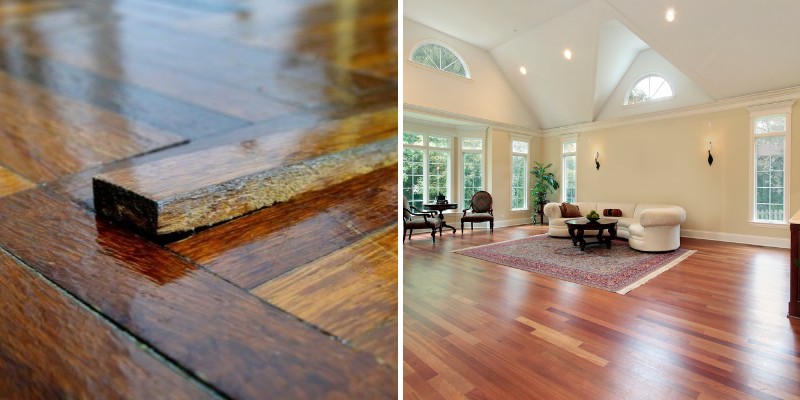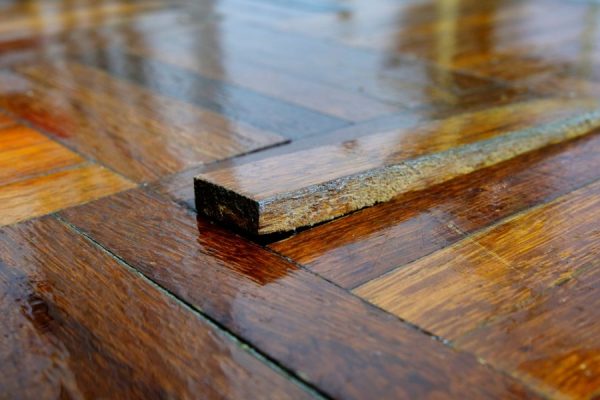Many people are now opting to install hardwood flooring in their homes due to the classic look and hard-wearing durability. Hardwood flooring can come in many different types and can make an impressive statement in any home.

Some advantages of hardwood flooring include its easy installation, the ease to clean, and its ability to fit in with a range of home decor styles.
The only thing with hardwood flooring which you may need to keep on top of is fixing any gaps that may appear over time.
This is something that you can only really prevent if your flooring has recently been fitted as it requires a lot of upkeep.
If the wood hasn’t been treated previously then the preventative measures may not have the same effect.
So why do gaps appear in hardwood floors? As temperature changes throughout the days or seasons, the wood expands and contracts in response.
You may not notice any gaps during the first couple of days of installation but after some weeks, gaps will start to show. These gaps are completely normal and can be easily fixed so don’t panic!

Let’s begin by running through some temporary measures…
Quick fixes
Like many things in life, there are some quick fixes you can opt for if your budget doesn’t stretch as far as a more permanent solution.
These are temporary fixes and they won’t last as long as the more long-lasting suggestions in this article however, it is worth noting their existence.
-
Putty Filler
Previously, putty filler was the way to go when fixing gaps in your hardwood floor.
However, many floor layers did start to see the negative effects that the putty filler brought with it which made them move on to different ways to fix this problem.
What they found is that over long periods the putty filler hardened and began to chip away.
This damages the flooring and makes it look even worse than when it had gaps in! The solution to this new problem is to dig out all of the old, hard putty, and replace it.
As you can imagine this is a very long-winded process so many flooring layers took to new ways of fixing the issues.
-
Wood Filler
Again, the use of wood filler is only a temporary measure. Wood filler is a slightly different consistency to putty which means that even when the filler is dry, your hardwood flooring will continue to expand and contract in line with the temperature of your home.
The only way to prevent the wood filler from moving with the wood is to keep the humidity of your home maintained throughout the day.
This can be quite difficult to keep on top of, especially if you work away from your home or have a budget set aside to spend on your A/C. If the gaps continue to be a concern for you then it would make sense to look for a more long-lasting measure.
We also advise that you only use a wood filler for smaller gaps in your hardwood flooring. Avoid using on larger gaps as it wouldn’t hold up too well!
Longer Lasting Solutions
A lot of people may want to skip the temporary fixes and jump straight into the long-lasting solutions.
These are way more cost-effective for you and they are much more durable.
Below we run through our top four fixes which could help fix your hardwood flooring gaps, big or small!
-
Flexible gap fillers
This is a great fix for any narrow gaps that start to form in your flooring. Instead of pushing filler out from the gap when your wood expands with heat, it flexibly adapts with your flooring.
Before use, make sure to vacuum to get rid of any debris which may impact the performance of the filler. The filler works just how a tube of caulk would so just cut the tube and apply it into any cracks. You will see a difference straight away!
-
Wood
A good option for any larger shaped gap is to use pieces of the same wood to fill them. To fill the gaps successfully, cut them to size, and apply some wood glue to the edges. Ensure that your room is humid before placing the wood into the gaps as this will have the best results.
As the wood would have expanded in the humidity, you may need to use some light force to place the wood into the gaps. You can do this by gently hitting the pieces of wood with a hammer. Be careful not to apply too much force as it could damage your flooring.
-
Rope
One of the oldest tricks in the book is to use rope pieces to fill any gaps in your hardwood flooring. You will need to cut these to size and push them into the gaps. The rope will need to be level with your wooden flooring for the best effect.
You may want to stain the rope to match the color of your flooring. This will make it blend in better with your hardwood floor instead of sticking out like a sore thumb. Using rope as a gap filler will also act as insulation which is a great bonus!
-
Sawdust
Maybe you’ve recently had your hardwood flooring installed and the carpenter left behind some sawdust. Well, you can use that sawdust to fill any gaps that appear over the next couple of days. Please note that this technique is only suitable for newly installed and unfinished flooring.
If you decide this is the best solution for you, get the sawdust and mix it with some polyurethane. This will create a thick paste that you can easily pour into the gaps you need to be filled.
Prevention Techniques
These prevention techniques will work for newly laid flooring or any restored wooden floors.
The best way to prevent gaps from forming in your hardwood floor is to wax it regularly. How regular is regularly? It depends on the type of wax you use.
You can either use liquid wax which will need to be reapplied every two years or you can use solid wax. Solid wax needs to be reapplied every two to five years.
If you’re still unsure how often to re-wax, contact the manufacturer of your flooring for further advice.
Full Replacement
In some instances, the gaps may be way past repair and your best bet would be to fully replace your wooden flooring. This option should only be considered if your flooring is damaged, old, warped, or have large gaps that require a lot of maintenance.
Replacing your flooring would initially seem like quite an expensive option. However, when you sit down and work out how much it would cost to do any of the repairs, it will probably work out to be more cost-effective to get new flooring.
If you do choose to replace your hardwood flooring, remember to stay on top of the upkeep by waxing regularly and filling any gaps that appear with our suggestions in this article!
Summary
We hope that our suggestions have sparked hope in you today. Your hardwood flooring gaps CAN be fixed after all!
Quick fixes are available but should only be temporary! They’re cheap but don’t last too long so may only be suitable for whilst you look into a more permanent solution.
When looking at a permanent fix, you have plenty of options. You just have to find the right choice for you. Whether you go for rope, sawdust, wood, or flexible fillers, you won’t be disappointed with your decision.
Looking after your hardwood flooring is super important but once it is maintained properly, you will see the beauty of it.
As long as you continue with its upkeep, you will have gorgeous flooring which everyone will be in awe of!
Related Posts
- Different Types of Finishes That Make Concrete Floors Aesthetically Appealing
- 10 Main Pros and Cons of Acid Stained Concrete Floors
- 3 Methods to Remove Candle Wax From Your Carpet (With Iron, Hair Dryer, Natural Products)
- 13 Types of Carpets for Your Home (By Material, Pile, Padding)
- How Much Does it Cost to Epoxy a Garage Floor? All Details Below
- 20 Different Types of Tiles for Home Flooring, Walls, Countertops, Backsplash
My floors are two years old, 5″ planks, darker color. I have narrow gaps here and there. What would be the best flexible filler? Do they come in different colors?
Thanks very much.
Sandra
Some options to look at include Timbermate or some of Elmer’s products